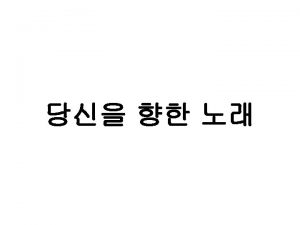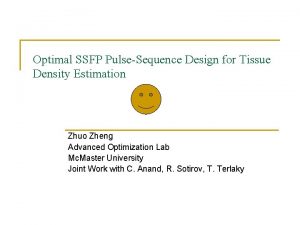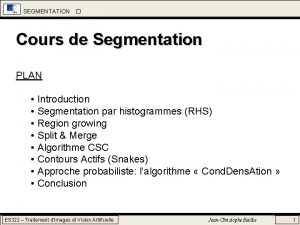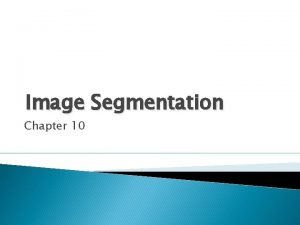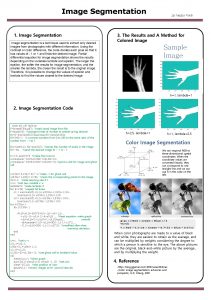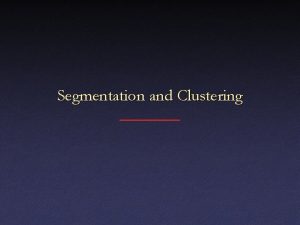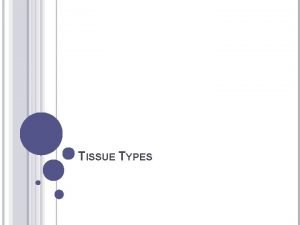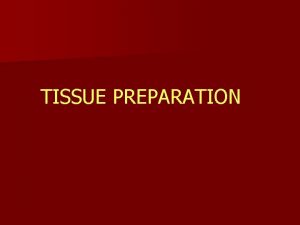Optimal SSFP PulseSequence Design For Tissue Segmentation Zhuo


















- Slides: 18

Optimal SSFP Pulse-Sequence Design For Tissue Segmentation Zhuo, ZHENG Advanced Optimization Lab Mc. Master University

Topics • Overview • Model • Optimization Problem • Future Work

Why is MRI? • Proton • Static field B 0 • RF Pulses Magnetization Aligned Flipped over

How is signal generated? • Precession (Rotate about Z axis) • Pulsed Magnetic Field Along X axis • Free Induction Decay

How is image reconstructed? • FE & Pulse Sequence • K-Space • Fourier Transformation (Restore Spatial Frequency Info in Place)

Tissue Segmentation Problem • Assuming different tissues combine linearly • Decrease noise by increasing the expected signal amplitude for each tissue • Concerned with min(eigenvalue) of the transformation from the vector space of tissue concentrations to itself given by a change of basis(why? )

Mathematical Model • Approximated by a discrete dynamical system • Magnetization as a unique fix-point (Steady-State) • Explicitly expressed as a function of design variables and parameters of the tissue properties.

Steady-State Signal • Short repetition time, fast scanning, good SNR (Signal-Noise Ratio) • Nontrivial function of many parameters tissue parameters design variables • Dynamic system expression (state-space model): Mk+1 = AMk + B

Reformulation of our Model • Write out A and B explicitly as A= B=

Characteristics of our Model • View steady-state as dynamic equilibrium For consecutive states: Mk+1 = Mk • A is a function of tissue parameters B is a function of design variables • Let Mk+1 = Mk = Mss (conventional notation) Then: (I – A)Mss= B, where (I – A) is nonsingular due to the physical mechanism

Problem Formulation • Transformation from tissue densities to measurements: • Let ε be a vector of measured noise, resulting errors are (STS)-1 STε • We obtain the optimization problem as follows:

Problem Formulation Mss(t, i) corresponding to tissue parameters t and design variables i

Optimization Problem • SDP with highly nonlinear and nonconvex constraints • Objective: choose design variables to minimize error(noise) • Increase ||A|| Decrease ||Mss|| Decrease ||S|| Reduce min(eigenvalue) of STS

How to solve (І) • Brute-force may be useful to get started • Get through all possible permutations of design variables: • Reliable yet time-consuming (number of iterations grows significantly)

Brute-force in our case • Calculate Mss for three different sets of and fill them into S matrix • Do SVD to S and keep updating the maximum of minimum singular value we obtain so far • Output those sets of and the maximum of minimum singular value.

Search Results Max=0. 0692 Iter=96000 α ƒ T SS 1 SS 2 20 40 75 120 3 3 SS 3 50 165 3 Max=0. 0742 Iter=3963900 α ƒ T SS 1 SS 2 SS 3 20 30 45 45 75 135 3 5. 1 6

How to solve (II) • Linearize constraints: Approximate nonlinear constraints by linear or quadratic functions by implicit differentiation and solve in Trust-Region The resulting linear system has the same LHS as the system for finding Mss(not hard to calculate)

Future Work • More precise mathematical model • Applying more sophisticated algorithms to solve the problem • Explore other approaches for tissue segmentation (CG iterative reconstruction based on undersampled raw data)
 Zhuo shi wo li liang
Zhuo shi wo li liang Jaringan epitel dapat ditemukan di
Jaringan epitel dapat ditemukan di Fspos vägledning för kontinuitetshantering
Fspos vägledning för kontinuitetshantering Typiska drag för en novell
Typiska drag för en novell Nationell inriktning för artificiell intelligens
Nationell inriktning för artificiell intelligens Returpilarna
Returpilarna Shingelfrisyren
Shingelfrisyren En lathund för arbete med kontinuitetshantering
En lathund för arbete med kontinuitetshantering Särskild löneskatt för pensionskostnader
Särskild löneskatt för pensionskostnader Personlig tidbok
Personlig tidbok A gastrica
A gastrica Förklara densitet för barn
Förklara densitet för barn Datorkunskap för nybörjare
Datorkunskap för nybörjare Stig kerman
Stig kerman Debatt mall
Debatt mall Autokratiskt ledarskap
Autokratiskt ledarskap Nyckelkompetenser för livslångt lärande
Nyckelkompetenser för livslångt lärande Påbyggnader för flakfordon
Påbyggnader för flakfordon Lufttryck formel
Lufttryck formel
